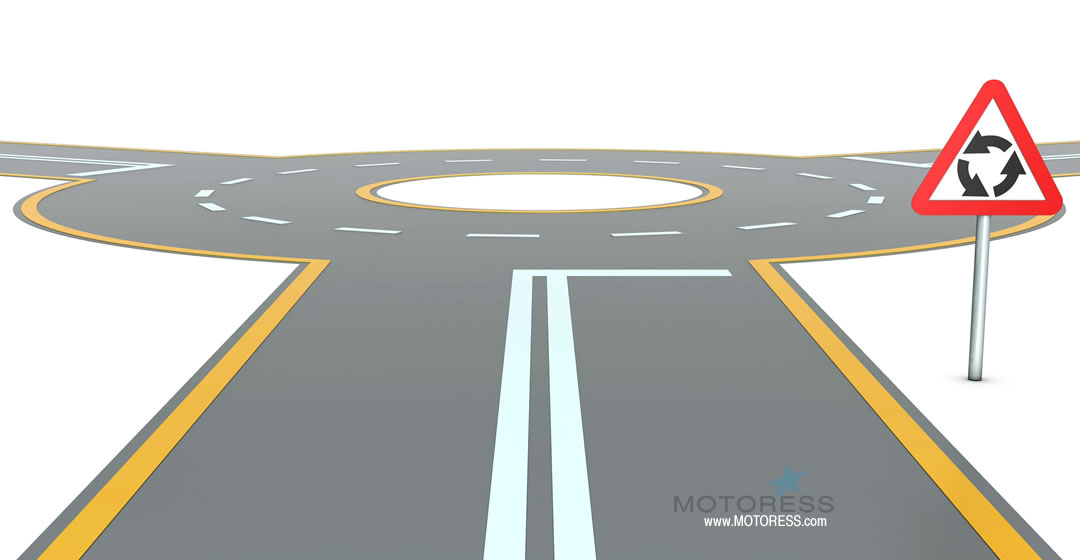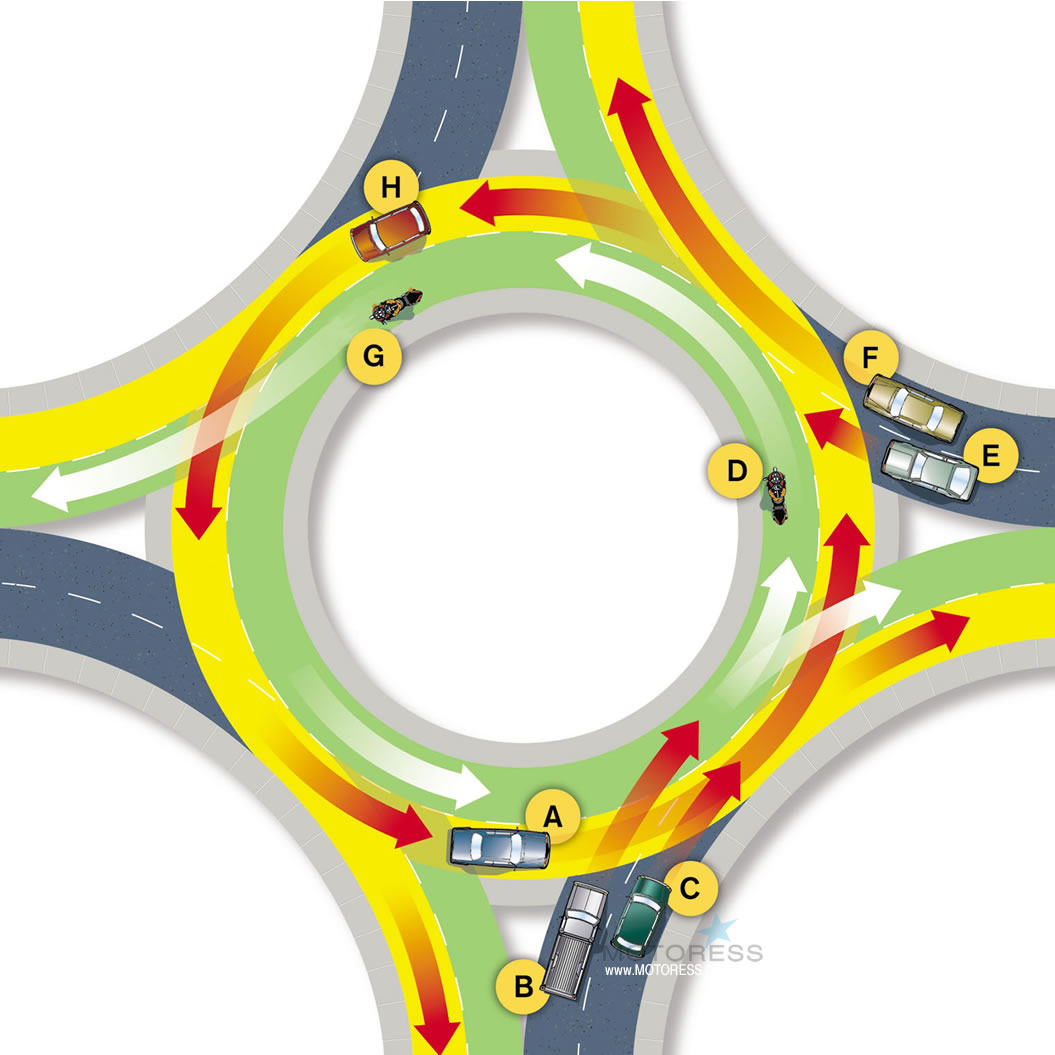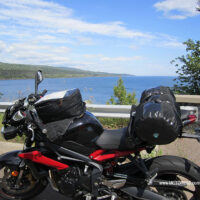Last Update: 28 October 2021

Roundabouts, these are the traffic flowing circle intersections most of us have all experienced them at one time or another. These “crazy traffic circles” have been making their appearances in North America but many riders – and drivers – are still not comfortably acquainted with their workings. Encountering a roundabout can “throw you for a loop” so to speak! Use this guide on how to navigate roundabouts to ensure success every time!
What Is a Roundabout?
Roundabouts were first developed from circular junction intersections, much like the Place de l ‘Étoile around the Arc de Triomphe in Paris. The first modern version of a roundabout was opened in 1899 in Germany. Since then, several iterations of the popular intersection have been developed.
Roundabouts are junctions that are advantageous because they allow traffic to continue without necessarily needing to stop. They also result in a form of “traffic calming”. They can best be described as intersections where multiple roads merge. But there can be disadvantages too, as often they are placed in high-density traffic areas. And this can be particularly challenging for motorcycle riders. In fact, roundabouts, just like intersections or junctions are road areas where the highest rate of accidents occurs.
Roundabouts promote a continuous flow of traffic. Unlike intersections with traffic signals, riders /drivers don’t have to wait for a green light [at a roundabout] to get through the intersection. Traffic is not required to stop – only yield – so the intersection can handle more traffic in the same amount of time.
More Benefits of Roundabouts
-
- Safety: lower speeds and fewer points of conflict between vehicles reduces the potential for serious crashes and injury.
- Lower speeds: unlike at a green light at an intersection, vehicles need to slow down to use a roundabout, reducing the likelihood of a serious crash.
- Higher capacity: a high volume of vehicles turning left is handled better by a roundabout than by a left turn signal at a traditional intersection.
- Fewer stops and shorter delays: yielding at the entry of a roundabout takes less time than waiting for a green light at an intersection or for a gap in traffic at a stop sign.
- Less idling and air pollution: fewer delays reduce fuel consumption and improves air quality by reducing emissions.
- Lower maintenance costs: roundabouts eliminate maintenance and electricity costs associated with traffic signals. *source Government Canada/MTO.
Roundabouts require vehicle operators to make their own decisions and assess others’ actions, rather than relying on third-party signals.
Some of The Downsides To Roundabouts:
-
- Driver uncertainty about yielding.
- Many roundabouts are busy, but can be complex, making observations challenging for other road users and particularly motorcyclists.
- Too many merge points, as some have multi-lanes.
- Driver speed.
- Drivers may try to “cut” the roundabout.
- Shoulder lane for bicyclists and pedestrians can be narrow if present at all.
Like other traffic intersections, it’s key that you carefully consider not only your own actions, but also consider drivers who might not be aware of you.

Rider Roundabout Guide
- The Approach – Pay Attention. Like any intersection or turn, as you approach adjust your speed, downshift and slow down. Think about where you want to go. If you’re not certain, look for signage to choose your exit.
- Pick Your Lane. Larger roundabouts will have multiple lanes. There will be signs that indicated where each lane leads – a visual. Try your best to use the correct lane for our destination. Use and move into the left lane to turn left or to go straight. Use the right lane (keep to the right) to turn right or to go straight. Do not enter a roundabout from the right lane if you want to turn left.
- Visual checks. Do mirror and blind spot checks – get the big picture. Note all vehicles already in the roundabout and those waiting to enter (including pedestrians and cyclists).
- Yield and Look Left! Traffic in the roundabout has the right-of-way. This is the golden rule of roundabouts. You must give right of way to any vehicle already in the roundabout (unless otherwise instructed). Adjust your speed or stop at the yield sign if necessary. And remember this is a yield, so you if the timing works, you won’t need to fully stop, but be sure to proceed cautiously and with control. When preparing to enter the roundabout, pay special attention to the vehicles to your left. When using the right lane either to go ahead at the roundabout or to take a right turn, always check traffic in the left lane before crossing into it. To keep it simple, the vehicle on the right must yield to the vehicle on the left.
- Ensure Adequate Gap/Spacing. Watch for a safe opportunity to enter the roundabout. Enter when there is an adequate gap in the circulating traffic flow. And be careful not to enter directly beside another vehicle already in the roundabout, as it might be exiting at the next exit.
- Counter-Clockwise Riding. Once in the roundabout, always keep to the right of the central/middle island and travel in a counterclockwise direction. Another golden rule in North America and other right hand drive countries.
- Keep Going. Once you are in the roundabout, do not stop except to avoid a collision; you have the right-of-way over entering traffic. Do not change lanes while in the roundabout. If in the inside lane and you miss your exit, you must continue around until you meet your exit again.
- Don’t Stop. There is no stopping within the roundabout (unless at a designated pedestrian crossing, or of course, to avoid a collision!) Once again, don’t change lanes within the roundabout.
- Look Out For Pedestrians. There may well be crosswalks within the roundabout. And just like any other crossing zone, stop if you see someone. They have priority.
- Be sure to use your signal indicators and communicate your course of direction. That’s key on a motorcycle and is mandatory (though many motorists fail to communicate effectively in traffic). Before you enter the roundabout, signal if going right or left but of course, no signal if going straight until you’re exiting to the right. Then put your indicator on so others know you’re going right. Signal intent to exit once you have passed the exit before the one you want, use your right-turn signal. Take the new road and check in your rear mirrors so that you know the situation all-round. Ensure your signals have cancelled or cancel them.
Once you’re in the roundabout ensure you employ the usual space cushions, correct tire track positions, and good spacing so you don’t become invisible behind the vehicle in front of you. Stay alert and aware of those around you and don’t forget those blind spot checks at every lane change!

In the diagram above, traffic indicated by red arrows in yellow lanes must yield to traffic indicated by white arrows in green lanes. Traffic entering the roundabout must yield to traffic in the roundabout.
- B and C must yield to A.
- E must yield to D while F and D proceed.
- H must yield to G.
For single-lane roundabouts, all the same rules apply, but you won’t need to choose a lane before entering.
How To Deal with Large Vehicles In a Roundabout
Allow extra room alongside large vehicles (trucks and buses). Large vehicles may have to swing wide on the approach or within the roundabout. Give them plenty of room. A driver negotiating a roundabout in a large vehicle (such as a truck or bus) may need to use the full width of the roadway, including the apron (a mountable portion of the centre island adjacent to the roadway) if provided. Prior to entering the roundabout, the vehicle may need to occupy both lanes. Give large vehicles plenty of room to manoeuvre.
How To Deal with Emergency Vehicles
Pull over for emergency vehicles. If you are in a roundabout when an emergency vehicle approaches, exit at your intended exit, and proceed beyond the traffic island before pulling over. If you have not entered the roundabout yet, pull over to the right if possible and wait until the emergency vehicle has passed.
Video: How to Use A Roundabout




